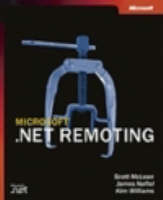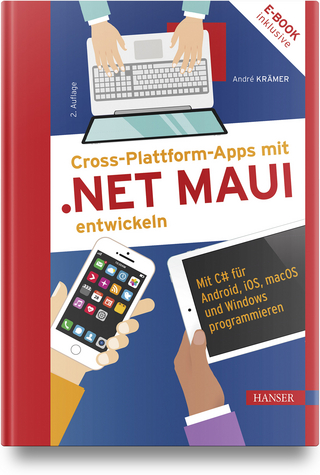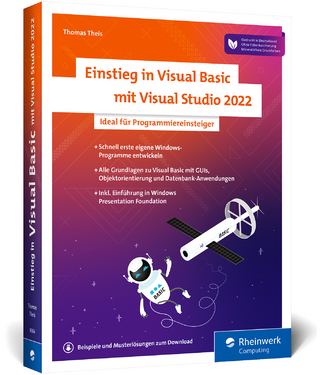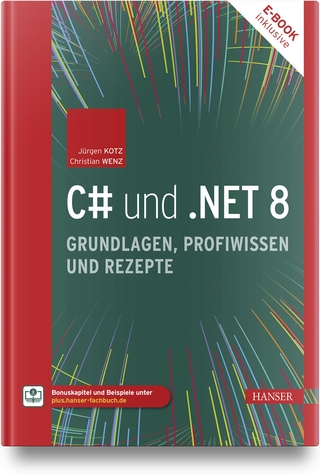
Microsoft .NET Remoting
Microsoft Press,U.S. (Verlag)
978-0-7356-1778-0 (ISBN)
- Titel ist leider vergriffen;
keine Neuauflage - Artikel merken
Provides developers with deep design and implementation guidance to help them build better distributed applications on the Microsoft .NET Framework
One third of the book introduces readers to the basics of using .NET Remoting to develop distributed application
Two-thirds of the book covers advanced features of .NET Remoting plus details on how to extend and customize the framework
James Naftel graduated from Georgia State University with a Bachelor of Science degree in Computer Science. After graduating, James was hired by XcelleNet, Inc., where he is now a lead software engineer. He’s worked in such diverse application domains as enterprise database application development and distributed systems, and he now leads a team developing database synchronization technology. He resides in the Atlanta, Georgia, area with his wife, two daughters, and two dogs. A cofounder of and contributer to www.thinkdotnet.com, to which he has contributed many articles, James has also written about Microsoft Visual Studio addins for Windows Developer Journal. His true passion is tinkering with programming languages, especially C++ and C#.
Introduction xi 1 Understanding Distributed Application Development 1 A Brief History 2 Distributed Architectures 2 Distributed Technologies 6 Distributed Objects A Welcome Abstraction 7 Benefits of Distributed Application Development 8 Fault Tolerance 8 Scalability 9 Administration 9 Challenges of Distributed Application Development 10 Performance 10 Security 12 Interoperability and Wire Formats 12 The Internet and Firewalls 12 Configuration 13 Location Independence 14 Object Lifetime Management 14 Using .NET Remoting to Meet the Challenges 14 Performance 15 Extending and Customizing Remoting 15 Configuration 16 CLR and CTS Benefits 17 Interoperability 18 Security 18 Lifetime Management 20 Enterprise Services 20 Summary 21 2 Understanding the .NET Remoting Architecture 23 Remoting Boundaries 23 Application Domains 24 Contexts 24 Crossing the Boundaries 24 Object Activation 28 Server Activated 29 Client Activated 32 An Object s Lease on Life 33 Leases 34 Lease Manager 35 Sponsors 36 Crossing Application Boundaries 37 Marshaling Remote Object References via an ObjRef 37 Clients Communicate with Remote Objects via Proxies 39 Messages Form the Basis of Remoting 41 Channels Transport Messages Across Remoting Boundaries 42 Channel Sink Chains Can Act on Messages 43 Summary 47 3 Building Distributed Applications with .NET Remoting 49 Designing a Distributed Job Assignment Application 50 Implementing the JobServer Application 50 Implementing the JobServer Application Logic 50 Adding .NET Remoting 55 Implementing the JobClient Application 63 Choosing a Client Application Domain 64 Obtaining the Server s Metadata 72 Configuring the JobClient Application for .NET Remoting 73 Exposing the JobServerImpl Class as a Web Service 77 Changes to the Sample Application 79 Using the SOAPSuds Tool 81 Adding Security to the Web Service 83 Using Role-Based Security with .NET Remoting 85 Extending the Sample with Client-Activated Objects 88 The JobNotes Class 88 JobClient Application Changes 90 Configuring the Client for .NET Remoting Client-Activated Objects 92 Configuring the Server for .NET Remoting Client-Activated Objects 94 Adding a Sponsor to the Lease 95 Metadata Dependency Issues 98 Removing the JobServer s Dependency on the JobClient s Metadata 98 Developing a Stand-In Class to Publish in Place of JobServerImpl Metadata 100 Remoting the IJobServer Interface 101 Summary 103 4 SOAP and Message Flows 105 Simple Object Access Protocol 105 Why Should We Care About SOAP? 106 HTTP-Based RPC 107 SOAP Message Elements 107 Document/Literal SOAP 110 Message Flows 110 The add_JobEvent Request Message 111 The add_JobEvent Response Message 116 The GetJobs Request Message 117 The GetJobs Response Message 117 The CreateJob Request Message 119 The CreateJob Response Message 119 The UpdateJobState Request Message 120 The UpdateJobState Response Message 120 The JobNotes Activation Request Message 121 The JobNotes Activation Response Message 122 The remove_JobEvent Request Message 124 The remove_JobEvent Response Message 128 Summary 129 5 Messages and Proxies 131 Messages 131 Construction Call Messages 132 Method Call Messages 132 Message Types 133 Proxies 135 TransparentProxy 135 RealProxy 136 Extending RealProxy 137 Custom Proxies in Practice 137 Summary 155 6 Message Sinks and Contexts 157 Message Sinks 157 IMessageSink 158 Synchronous Message Processing 159 Asynchronous Message Processing 160 Understanding Contexts 161 Establishing a Context 162 Context Attributes and Properties 162 Contexts and Remoting 165 Dynamic Context Sinks 167 Client Context Sink Chain 169 Server Context Sink Chain 170 Server Object Sink Chain 178 Envoy Sink Chain 183 Summary 193 7 Channels and Channel Sinks 195 How Channels Are Constructed 195 Channel Terminology 196 HttpChannel 196 HttpServerChannel 199 HttpServerTransportSink 201 HttpClientChannel 202 HttpClientTransportSinkProvider 202 HttpClientTransportSink 203 Creating Custom Channels 204 The Steps for Creating a Custom .NET Remoting Channel 204 Creating the Custom Channel FileChannel 205 Implementing a Custom Channel Sink 232 Creating the AccessTime Custom Sink 233 Summary 240 8 Serialization Formatters 241 Object Serialization 241 Serializable Attribute 242 Customizing Object Serialization 243 Object Graph Serialization 246 Object Graph Deserialization 248 Serialization Surrogates and Surrogate Selectors 249 Serialization Formatters 253 Obtaining a Type s Serializable Members 253 Traversing an Object Graph 255 Using the ObjectManager Class 257 Using the Formatter Class 261 Implementing a Custom Serialization Formatter 262 Creating a Formatter Sink 288 Client Formatter Sink 288 Server Formatter Sink 293 Summary 298 INDEX 299
| Erscheint lt. Verlag | 25.9.2002 |
|---|---|
| Verlagsort | Redmond |
| Sprache | englisch |
| Maße | 187 x 229 mm |
| Themenwelt | Mathematik / Informatik ► Informatik ► Netzwerke |
| Informatik ► Programmiersprachen / -werkzeuge ► NET Programmierung | |
| Mathematik / Informatik ► Informatik ► Web / Internet | |
| ISBN-10 | 0-7356-1778-3 / 0735617783 |
| ISBN-13 | 978-0-7356-1778-0 / 9780735617780 |
| Zustand | Neuware |
| Haben Sie eine Frage zum Produkt? |
aus dem Bereich


